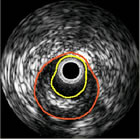| << To Blog Home >> | |
|
|
May 4, 2009 -- 12:45pm EDT Effectiveness in Stenting
Huennekens' piece was titled, "Obama effectiveness proposal: a tool for finding faster, less expensive medical solutions? " and he details why he agrees with and supports President Obama's decision to study "comparative effective research" -- primarily because there are a number of ways that new technologies, many of them (of course) manufactured by his company, will be useful for interventional cardiology.
Another is Fractional Flow Reserve (FFR) which can measure whether or not a blockage seen to be significant on an angiogram is in fact obstructing blood flow, and how much. The recently published FAME study, detailed in our piece, "Better Outcomes for Stents When Fractional Flow Reserve (FFR) is Used", showed 28% reduction in major cardiac events when FFR was used to determine which blockages to stent and which to leave alone. Also one-third less stents were used: more effective therapy and more cost-effective too. We continue to cover other areas where the effectiveness of catheter-based therapy can be improved. Our Transradial Access Center details the ways in which bleeding complications can be reduced, just by changing the access site for diagnostic and interventional procedures. And we're closely following the use of other imaging modalities, like Cardiac CT angiography (CCTA) which shows promise in eliminating a significant number of invasive diagnostic caths by accurately ruling out coronary disease -- and Optical Coherence Tomography (OCT) which may help in determining stent strut coverage and whether it is safe for the patient to stop taking antiplatelet drugs, such as Plavix. Innovation in medicine may not only be cost-effective, it may be profitable as well. In an excerpt from The Wall Street Transcript's annual Medical Device issue, Matt Dolan of ROTH Capital Partners predicts that, counter to some companies, Volcano is looking at a continued growth rate of 20%. Very effective, indeed. (By the way, the photo posted with Scott Huennekens' op-ed on the Washington Times web site is NOT Huennekens, but Montana Senator Max Baucus -- go figure.... Huennekens is pictured correctly at the top of this article.) |
|


 Aside
from stents themselves, there's a whole toolbox of devices and techniques
that are candidates for "comparative
effectiveness" in that they may be able to increase the success
of interventional procedures -- or even target patients who need these
procedures more accurately. As Volcano Corp.'s CEO Scott Huennekens
wrote in a
Aside
from stents themselves, there's a whole toolbox of devices and techniques
that are candidates for "comparative
effectiveness" in that they may be able to increase the success
of interventional procedures -- or even target patients who need these
procedures more accurately. As Volcano Corp.'s CEO Scott Huennekens
wrote in a  Among
them is intravascular ultrasound (IVUS) which shows
more accurate
information about stent placement and expansion than can be seen
on an angiogram. Last July Angioplasty.Org posted an article titled,
"
Among
them is intravascular ultrasound (IVUS) which shows
more accurate
information about stent placement and expansion than can be seen
on an angiogram. Last July Angioplasty.Org posted an article titled,
"